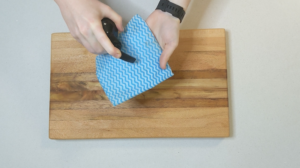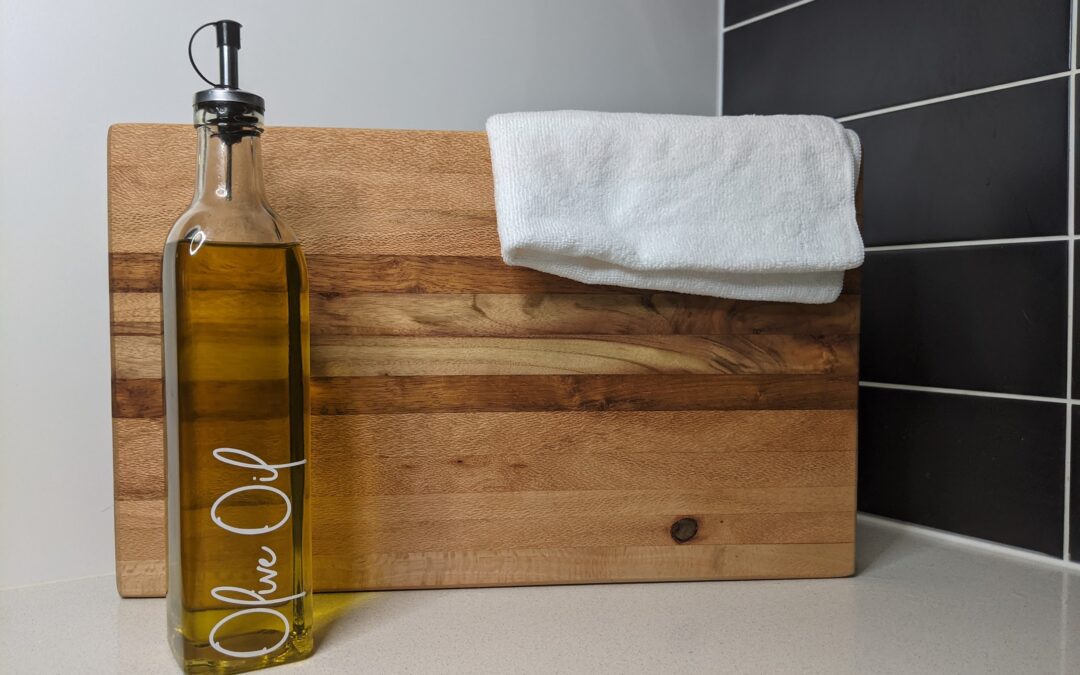Durability and reliability are two of the main reasons home chefs love wood cutting & serving boards. They’re:
- Attractive
- Do not easily harbour harmful bacteria
- Won’t dull your knives.
The largest misunderstanding is that they’re hard to clean and maintain – and aren’t dishwasher safe (😱). It’s not that hard at all to learn how to clean a wood board, and make it last your lifetime with these easy steps.
“Hardwoods, like maple, are fine-grained, and the capillary action of those grains pulls down fluid, trapping the bacteria – which are killed off as the board dries after cleaning”
says Ben Chapman, a food safety researcher at NC State.
What you will need in advance
• Wooden cutting/serving board
• Clean, microfibre towel (or a soft alternative. Paper towels are okay)
• Vegetable oil, or other food-grade oil
• Half a lemon (optional – for cleaning funky smells)
• Course salt (optional – for cleaning funky smells)
Instructions

Clean your board daily by using gentle dish soap, and a cloth.
1. Prepare the board: Firstly, using a gentle dish soap, clean the wood by using a lukewarm damp cloth, be sure to clean both sides so that you avoid warping. Secondly, to remove any strange smells (like garlic) start by scrubbing half a lemon into the board, followed by a generous sprinkle of salt. Redo the scrub again with lemon (tip: add droplets of water if lemon isn’t juicy enough). Lastly, give it a scrape down, another gentle wash and set it on its side to dry overnight.
2. Apply the oil: Using a clean microfibre towel, apply the oil in an even layer over the wood, massaging it gently in and applying to all sides.
3. Give it time to soak in:Leave the oil to soak in, overnight if possible, or for at least a few hours so that it can penetrate the wood and rehydrate it.
4. Remove the excess: Use another dry, clean cloth or paper towel, and buff off any remaining oil so that the board does not feel damp or sticky.
Helpful tips
• Avoid direct exposure to heat or sunlight
• Hand wash with mild detergent (avoid the dishwasher)
• Do not immerse in water
• Dry on its side
• Periodically grease with a small amount of vegetable or olive oil, rubbing gently with a soft cloth.
When it’s time to replace your trusty board
There comes a time when scrubbing and sanitising won’t be enough. This usually happens when your board has accumulated a lot of deep grooves from repeated use, therefore trapping more moisture as a place for bacteria to proliferate.
“The more grooves it has, and the bigger they are, the more area is available for trapping moisture and giving bacteria a place to proliferate,” Chapman says.



Good info! I’ll clean and oil my new chopping board tomorrow.
I’ve got an old wooden board that is bowed up in the middle. Is there any way to fix it?
Hi John,
To fix a bowed board you could try the ironing method where you place a towel on top, and use an iron to draw the moisture out. We don’t have any videos on it, but I’m sure there’s plenty online to get you started.
Thank you for dropping by!